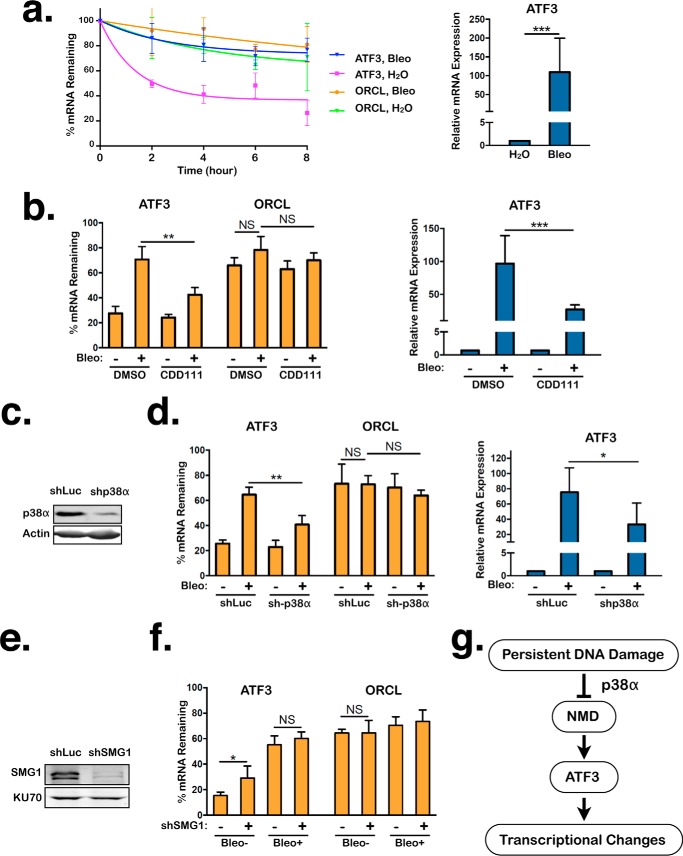Figure 6.
NMD suppression by p38α in response to persistent DNA damage contributes to ATF3 mRNA stabilization. a, left panel, percentage of ATF3 and ORCL mRNAs remaining in RPE1 reporter cells after 24-h treatment with either H2O or bleomycin (Bleo), followed by 96-h recovery. Following the recovery period, actinomycin D was added, and total RNA was collected at the indicated times, followed by quantitative RT-PCR analysis. The difference in ATF3 stability between H2O- or bleomycin-treated cells is statistically significant (p ≤ 0.01, paired t test) for each time point. No significant stabilization of ORCL mRNA was observed between H2O- or bleomycin-treated cells. Data represent the mean ± S.D. of three independent experiments. Right panel, steady-state levels of ATF3 transcripts in RPE1 reporter cells after 24-h treatment with either H2O or bleomycin, followed by 96-h recovery. Expression in the H2O-treated cells was normalized to 1. Data represent the mean ± S.D. of five independent experiments. ***, p ≤ 0.001 (paired t test). b, left panel, percentage of ATF3 and ORCL mRNAs remaining in DMSO- and CDD111-treated RPE1 reporter cells after 24-h treatment with either H2O or bleomycin, followed by 96-h recovery and then actinomycin D treatment for 6 h. Samples were collected immediately before or after 6-h treatment with actinomycin D. Right panel, steady-state levels of ATF3 transcripts in DMSO- and CDD111-treated RPE1 cells after 24-h treatment with either H2O or bleomycin, followed by 96-h recovery. Expression in the H2O-treated cells was normalized to 1. Data represent the mean ± S.D. of five independent experiments. **, p ≤ 0.01; ***, p ≤ 0.001 (paired t test). NS, p > 0.05. c, shRNA-mediated knockdown of p38α in RPE1 cells. d, left panel, percentage of ATF3 and ORCL mRNAs remaining in control and p38α knockdown RPE1 reporter cells after 24-h treatment with either H2O or bleomycin, followed by 96-h recovery. Samples were collected as in b. Right panel, steady-state levels of ATF3 transcripts in control and p38α knockdown-treated RPE1 reporter cells after 24-h treatment with either H2O or bleomycin, followed by 96-h recovery. Expression in the H2O-treated cells was normalized to 1. Data represent the mean ± S.D. of four independent experiments. *, p ≤ 0.05; **, p ≤ 0.01 (paired t test). NS, p > 0.05. e, shRNA-mediated knockdown of SMG1 in RPE1 cells. f, percentage of ATF3 and ORCL mRNAs remaining in control- and SMG1 knockdown RPE1 cells that were treated with either H2O or bleomycin for 24 h, followed by 96-h recovery. Actinomycin D was added to cells to suppress transcription, and total RNA was collected immediately before or 6 h after addition of actinomycin D, followed by quantitative RT-PCR analysis. Data represent the mean ± S.D. of four independent experiments. *, p ≤ 0.05; NS, p > 0.05 (paired t test). g, model for the regulation of NMD activity by p38α in response to persistent DNA damage that leads to the stabilization of ATF3 mRNAs and subsequent changes in transcription and gene expression.

